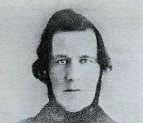William Howe
 William Howe of Spencer, Massachusetts was born in 1803. He filed a patent for his truss design in 1840 which consisted of crossed timbers in a "X" pattern. His structure was similar to Stephen Long's truss except that he replaced the upright vertical timbers with metal rods. The metal rods could be adjusted by tightening the nuts or turnbuckles thereby retaining the strength of the truss both during and after construction of the bridge. He was the first to use metal components as primary members. His method made it possible for bridges to withstand heavy loads used by railroads. Although more expensive to build, his truss was widely popular and virtually ended the need for the Long truss. Colonel Long claimed patent infringement by Howe but his case was unfounded. Many considered Howe's truss to be the beginning of the iron bridge age. More iron than wood bridges were built in the late 1800s.
William Howe of Spencer, Massachusetts was born in 1803. He filed a patent for his truss design in 1840 which consisted of crossed timbers in a "X" pattern. His structure was similar to Stephen Long's truss except that he replaced the upright vertical timbers with metal rods. The metal rods could be adjusted by tightening the nuts or turnbuckles thereby retaining the strength of the truss both during and after construction of the bridge. He was the first to use metal components as primary members. His method made it possible for bridges to withstand heavy loads used by railroads. Although more expensive to build, his truss was widely popular and virtually ended the need for the Long truss. Colonel Long claimed patent infringement by Howe but his case was unfounded. Many considered Howe's truss to be the beginning of the iron bridge age. More iron than wood bridges were built in the late 1800s.
Like most other bridge patent holders, Howe was not interested in bridge building. He spent most of his time with his inventions and improving on his patent. William Howe made improvements to his design with a new patent in 1850. Howe's bridges extended from Maine to California, many used by railroads. His bridges consisted mostly of white oak, pine, fir, hemlock or cedar. He died a rather young man at the age of 49.
Back to Trusses
Maryland Covered Bridges
Email me: mdcoveredbridges@comcast.net
William Howe of Spencer, Massachusetts was born in 1803. He filed a patent for his truss design in 1840 which consisted of crossed timbers in a "X" pattern. His structure was similar to Stephen Long's truss except that he replaced the upright vertical timbers with metal rods. The metal rods could be adjusted by tightening the nuts or turnbuckles thereby retaining the strength of the truss both during and after construction of the bridge. He was the first to use metal components as primary members. His method made it possible for bridges to withstand heavy loads used by railroads. Although more expensive to build, his truss was widely popular and virtually ended the need for the Long truss. Colonel Long claimed patent infringement by Howe but his case was unfounded. Many considered Howe's truss to be the beginning of the iron bridge age. More iron than wood bridges were built in the late 1800s.